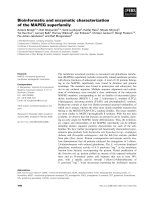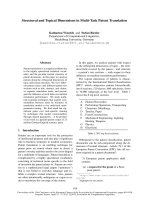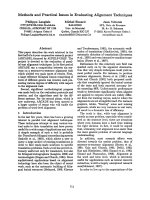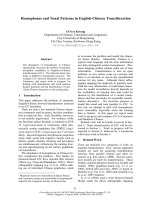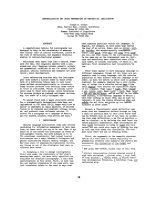Báo cáo khoa học: "Methods and Practical Issues in Evaluating Alignment Techniques" doc
Bạn đang xem bản rút gọn của tài liệu. Xem và tải ngay bản đầy đủ của tài liệu tại đây (590.84 KB, 7 trang )
Methods and Practical Issues in Evaluating Alignment Techniques
Philippe
Langlais
CTT/KTH SE-I0044 Stockholm
CERI-LIA, AGROPARC
BP 1228
F-84911
Avignon Cedex
9
Philippe.Langlais~speech.kth.se
Michel
Simard
RALI-DIRO
Univ. de Montrdal
Qudbec, Canada H3C 3J7
shnardm~IRO.UMontreal.CA
Jean Vdronis
LPL, Univ. de Provence
29, Av. R. Schuman
F-13621 Aix-en-Provence Cedex 1
veronis~univ-aix.fr
Abstract
This paper describes the work achieved in the
first half of a 4-year cooperative research project
(ARCADE), financed by AUPELF-UREF. The
project is devoted to the evaluation of paral-
lel text alignment techniques. In its first period
ARCADE ran a competition between six sys-
tems on a sentence-to-sentence alignment task
which yielded two main types of results. First,
a large reference bilingual corpus comprising of
texts of different genres was created, each pre-
senting various degrees of difficulty with respect
to the alignment task.
Second, significant methodological progress
was made both on the evaluation protocols and
metrics, and the algoritbm.q used by the dif-
ferent systems. For the second phase, which is
now underway, ARCADE has been opened to
a larger number of teams who will tackle the
problem of word-level alignment.
1 Introduction
In the last few years, there has been a growing
interest in parallel text alignment techniques.
These techniques attempt to map various tex-
tual units to their translation and have proven
useful for a wide range of applicatious and tools.
A simple example of such a tool is probably
the
TransSearch
bilingual concordancing system
(Isabelle et al., 1993), which allows a user to
query a large archive of existing translations in
order to find ready-made solutions to specific
translation problems. Such a tool has proved ex-
tremely useful not only for translators, but also
for bilingual lexicographers (Langlois, 1996) and
terminologists (Dagan and Church, 1994). More
sophisticated applications based on alignment
technology have also been the object of recent
work, such as the automatic building of bilin-
gual lexical resources (Melamed, 1996; Klavans
and Tzoukermann, 1995), the automatic verifi-
cation of translations (Macklovitch, 1995), the
automatic dictation of translations (Brousseau
et al., 1995) and even interactive machine trans-
lation (Foster et al., 1997).
Enthusiasm for this relatively new field was
sparked early on by the apparent demonstra-
tion that very simple techniques could yield al-
most perfect results. For instance, to produce
sentence alignments, Brown et al. (1991) and
Gale and Church (1991) both proposed meth-
ods that completely ignored the lexical content
of the texts and both reported accuracy lev-
els exceeding 98%. Unfortunately performance
tends to deteriorate significantly when aligners
are applied to corpora which are widely differ-
ent from the training corpus, and/or where the
alignments are not straightforward. For instance
graphics, tables, "floating" notes and missing
segments, which are very common in real texts,
all result in a dramatic loss of efficiency.
The truth is that, while text alignment is
mostly an easy problem, especially when consid-
ered at the sentence level, there are situations
where even humans have a hard time making
the right decision. In fact, it could be argued
that, ultimately, text alignment is no easier than
the more general problem of natural language
understanding.
In addition, most research efforts were
directed towards the easiest problem, that of
sentence-to-sentence alignment (Brown et al.,
1991; Gale and Church, 1991; Debili, 1992;
Kay and l~scheisen, 1993; Simard et al., 1992;
Simard and Plamondon, 1996). Alignment at
the word and term level, which is extremely
useful for applications such as lexieal resource
extraction, is still a largely unexplored research
area(Melamed, 1997).
In order to live up to the expectations of the
711
various application fields, alignment technology
will therefore have to improve substantially.
As was the case with several other language
processing techniques (such as information
retrieval, document understanding or speech
recognition), it is likely that a systematic evalu-
ation will enable such improvements. However,
before the ARCADE project started, no for-
real evaluation exercise was underway; and
worse still, there was no multilingnal aligned
reference corpus to serve as a "gold standard"
(as the Brown corpus did, for example, for
part of speech tagging), nor any established
methodology for the evaluation of alignment
systems.
2 Organization
ARCADE is an evaluation exercise financed
by AUPELF-UREF, a network of (at least
partially) French-speaking universities. It was
launched in 1995 to promote research in the
field of multilingual alignment. The first 2-year
period (96-97) was dedicated to two main
tasks: 1) producing a reference bilingual corpus
(French-English) aligned at sentence level; 2)
evaluating several sentence alignment systems
through an ARPA-like competition.
In the first phase of ARCADE, two types of
teams were involved in the project: the corpus
providers (LPL and RALI) and the (RALI, LO-
ILIA, ISSCO, IRMC and LIA). General coor-
dination was handled by J. V~ronis (LPL); a
discussion group was set up and moderated by
Ph. Langlais (LIA & KTH).
3 Reference corpus
One of the main results of ARCADE has been
to produce an aligned French-English corpus,
combining texts of different genres and various
degrees of difficulty for the alignment task. It
is important to mention that until ARCADE,
most alignment systems had been tested on ju-
dicial and technical texts which present rela-
tively few difficulties for a sentence-level align-
ment. Therefore, diversity in the nature of the
texts was preferred to the collection of a large
quantity of similar data.
3.1 Format
ARCADE contributed to the development
and testing of the Corpus Encoding Standard
(CES), which was initiated during the MUL-
TEXT project (Ide et al., 1995). The CES is
based on SGML and it is an extension of the
now internationally-accepted recommendations
of the Text Encoding Initiative (Ide and
Vdronis, 1995). Both the JOG and BAF parts
of the ARCADE corpus (described below) are
encoded in CES format.
3:2 JOC
The JOC corpus contains texts which were pub-
lished in 1993 as a section of the C Series of the
Official Journal of the European Community in
all of its official languages. This corpus, which
was collected and prepared during the MLCC
and MULTEXT projects, contains, in 9 parallel
versions, questions asked by members of the Eu-
ropean Parliament on a variety of topics and the
corresponding answers from the European Com-
mission. JOC contains approximately 10 million
words (ca. 1.1 million words per language). The
part used for JOC was composed of one fifth
of the French and English sections (ca. 200 000
words per language).
3.3 BAF
The BAF corpus is also a set of parallel French-
English texts of about 400 000 words per lan-
guage. It includes four text genres: 1)
INST,
four institutional texts (including transcription
of speech from the Hansard corpus) for a total-
ing close to 300 000 words per language, 2) SCI-
ENCE, five scientific articles of about 50 000
words per language, 3) TECH, technical doc-
umentation of about 40 000 words per language
and 4) VERNE, the Jules Verne novel: "De
la terre d la lune" (ca. 50 000 words per lan-
guage). This last text is very interesting because
the translation of literary texts is much freer
than that of other types of tests. Furthermore,
the English version is slightly abridged, which
adds the problem of detecting missing segments.
The BAF corpus is described in greater detail
in (Simard, 1998).
4 Evaluation measures
We first propose a formal definition of paral-
lel text alignment, as defined in (Isabelle and
Simard, 1996). Based on that definition, the
usual notions of recall and precision can be used
to evaluate the quality of a given alignment with
712
respect to a reference. However, recall and preci-
sion can be computed for various levels of gran-
ularity: an alignment at a given level (e.g. sen-
tences) can be measured in terms of units of a
lower level (e.g. words, characters). Such a fine-
grained measure is less sensitive to segmenta-
tion problems, and can be used to weight errors
according to the number of sub-units they span.
4.1 Formal definition
If we consider a text S and its translation T as
two sets of segments S = {Sl, s2, ,
Sn} and T =
{tl,t2, ,tm}, an alignment A
between S and
T can be defined as a subset of the Cartesian
product ~(S)
x
p(T), where p(S) and p(T) are
respectively the set of all subsets of S and T.
The triple iS, T, A) will be called a
bitext. Each
of the elements (ordered pairs) of the alignment
will be called a
bisegment.
This definition is fairly general. However, in
the evaluation exercice described here, segments
were sentences and were supposed to be contigu-
ous, yielding
monotonic alignments.
For instance, let us consider the fol-
lowing alignment, which will serve as the
reference alignment
in the subsequent ex-
amples. The formal representation of it is:
Ar
= {({Sl}, {tl}), ({s2}, {t2,t3})}.
sl Phrase num~ro un.
s2 Phrase num~ro deux
qui ressemble h la l~re.
tl The first sentence.
t2 The 2nd sentence.
t3
It looks like the first.
4.2 Recall and precision
Let us consider a bitext
(S,T, Ar) and a
proposed alignment A. The alignment
recall
with respect to the reference Ar is defined
as: recall = IA N
Arl/IA~I.
It represents the
proportion of bisegments in A that are correct
with respect to the reference At. The
silence
corresponds to 1-
recall.
The alignment
precision
with respect to the reference Ar
is defined as:
precision = IA N Arl/IAI.
It
represents the proportion of bisegments in A
that are right with respect to the number of
bisegment proposed. The
noise
corresponds to
1 precision.
We will also use the
F-measure
(Rijsbergen,
1979) which combines recall and precision in
a single efficiency measure (harmonic mean of
precision and recall):
(recall
x
precision)
F
2" ( recall~ + precision)"
Let us assume the following proposed align-
ment:
sl Phrase num~ro un. tl The first sentence.
t2 The 2nd sentence.
s2 Phrase num~ro deux t3 It looks like the first.
qui ressemble h la l~re.
The formal representation of this alignment
is: A
=
{({s,}, ({}, {t2}), ({s2}, {t3})}.
We
note that:
A n Ar
=
{((s,}, {tl})}.
Align-
ment recall and precision with respect to
Ar are
1/2 0.50 and 1/3 0.33 respectively. The F-
measure is 0.40.
Improving both recall and precision are an-
tagonistic goals : efforts to improve one often
result in degrading the other. Depending on the
applications, different trade-offs can be sought.
For example, if the bisegments are used to auto-
matically generate a bilingual dictionary, maxi-
mizing precision (i.e. omitting doubtful couples)
is likely to be the preferred option.
Recall and precision as defined above are
rather unforgiving. They do not take into ac-
count the fact that some bisegments could be
partially correct. In the previous example, the
bisegment ({s2}, {t3}) does not belong to the
reference, but can be considered as partially cor-
rect: t3 does match a part of s2. To take partial
correctness into account, we need to compute re-
call and precision at the sentence level instead
of the alignment level.
Assuming the alignment A = {al, a2, , am}
and the reference Ar = {arl,
at2, ,
am}, with
ai = (asi, ati)
and
arj = (arsj,artj),
we can
derive the following sentence-to-sentence align-
ments:
A'
=
Ui(asi × ati)
A~r = Uj(arsj x artj)
Sentence-level recall and precision can thus
be defined in the following way:
recall =
IA' ' '
nArl/lArl
precision = IA'
n
A'rl/IA'I
In the example above: A' = {(sl, tl), (s2, t3)}
and A~ = {(sl, tl), (s2, t2), (s2, t3)}. Sentence-
level recall and precision for this example are
713
therefore 2/3 = 0.66 and 1 respectively, as com-
pared to the alignment-level recall and preci-
sion, 0.50 and 0.33 respectively. The F-measure
becomes 0.80 instead of 0.40.
4.3 Granularity
In the definitions above, the sentence is the unit
of granularity used for the computation of recall
and precision at both levels. This results in two
difficulties. First, the measures are very sensi-
tive to sentence segmentation errors. Secondly,
they do not reflect the seriousness of misalign-
ments. It seems reasonable that errors involving
short sentences should be less penalized than
errors involving longer ones, at least from the
perspective of some applications.
These problems can be avoided by taking ad-
vantage of the fact that a unit of a given gran-
~arity (e.g. sentence) can always be seen as
a (possibly discontinuous) sequence of units of
finer granularity (e.g. character).
Thus, when an alignment A is compared to
a reference alignment Ar using the recall and
precision measures computed at the char-level,
the values obtained are inversely proportional to
the quantity of text (i.e. number of characters)
in the misaligned sentences, instead of the num-
ber of these misaligned sentences. For instance,
in the example used above, we would have at
sentence level:
* using word granularity (punctuation marks
are considered as words) :
IA'I = 4*4 + 0*4 + 9*6 = 106
IAr'l = 4*4 + 9.10 = 70
IAr'
"
A'I = 4*4 + 9*6 = 70
recall = 70/106 = 0.66
precision =
1
F = 0.80
• using character granularity (excluding
spaces):
[A'[ = 15.17 + 0.15 + 36*20 = 975
[Ar'] = 15.17 + 36*35 = 1515
IAr' " A'I = 15.17 + 36*20 = 975
recall = 975/1515 = 0.64
precision = 1
F=0.78
5 Systems tested
Six systems were tested, two of which having
been submitted by the I:tALI.
RALI/Jacal This system uses as a first step
a program that reduces the search space only to
those sentence pairs that are potentially inter-
esting (Simard and Plamondon, 1996). The un-
derlying principle is the automatic detection of
isolated cognates (i.e. for which no other similar
word exists in a window of given size). Once the
search space is reduced, the system aligns the
sentences using the well-known sentence-length
model described in (Gale and Church, 1991).
RALI/Sallgn The second method proposed
by RALI is based on a dynamic programming
scheme which uses a score function derived from
a translation model similar to that of (Brown
et al., 1990). The search space is reduced to a
beam of fixed width around the diagonal (which
would represent the alignment if the two texts
were perfectly synchronized).
LORIA The strategy adopted in this system
differs from that of the other systems since sen-
tence alignment is performed after the prelim-
inary alignment of larger units (whenever pos-
sible, using mark-up), such as paragraphs and
divisions, on the basis of the SGML structure.
A dynamic programming scheme is applied to
all alignment levels in successive steps.
IRMC This system involves a preliminary,
rough word alignment step which uses a trans-
fer dictionary and a measure of the proximity of
words (D~bili et al., 1994). Sentence alignment
is then achieved by an algorithm which opti-
mizes several criteria such as word-order con-
servation and synchronization between the two
texts.
LIA Like Jacal, the LIA system uses a
pre-processing step involving cognate recog-
nition which restricts the search space, but
in a less restrictive way. Sentence alignment
is then achieved through dynamic program-
ming, using a score function which combines
sentence length, cognates, transfer dictionary
and frequency of translation schemes (1-1, 1-2,
etc.).
ISSCO Like the LORIA system, the ISSCO
aligner is sensitive to the macro-structure of
the document. It examines the tree structure
of an SGML document in a first pass, weighting
each node according to the number of charac-
ters contained within the subtree rooted at that
node. The second pass descends the tree, first
714
by depth, then by breath, while aligning sen-
tences using a method resembling that of Gale
& Church.
6
Results
Four sets of recall/precision measures were com-
puted for the alignments achieved by the six
systems for each text type previously described
above: Align, alignment-level, Sent sentence-
level, Word, word-level and Char, character-
level. The global efficiency of the different sys-
tems (average F-values) for each text type is
given in Figure 1.
t.ORJA t ! I "
• . W~ -II -
I,IA : . . [.J! i 1 • ! ,
TECJH
,.~ i i id~ i ii.i_~?~'r i
• i "¢¢-~, : ~m.:
LIA ~ i ~b-~
~ i
:
! : IX,'~ ]
SC~'~ !
' ~. ! ! i ! ~ ! ~ ""
.
SCH~CI
! !
• ~ s.,4~.~ ! ! . i
i
a~o ~:T', ,
"~
• ,,-IH i ii iii i i i i
i.oll.l~l!~l i i iiiiii ! i i i
ii i i ~ i i i iiii i i i i ~,.t- '
I ~ i i i '~ ,,~.1~
'ii'
! i
i i! ii ,
"i
i
I , ~i i i 1o<
r.,i Ill ~ i Is l
Figure h Global efficiency (average F-values for
Align, Sent, Word and Char measures) of the
different systems (Jacal, Salign, LORIA, IRMC,
ISSCO, LIA), by text type (logarithmic scale).
First, note than the
Char
measures are higher
that the
Align
measures. This seems to con-
firm that systems tend to fail when dealing
with shorter sentences. In addition, the refer-
ence alignment for the BAF corpus combines
several 1-1 alignments in a single n-n align-
ment, for practical reasons owing to the sen-
tence segmentation process. This results in de-
creased
Align
measures.
The corpus on which all systems scored high-
est was the JOC. This corpus is relatively sim-
ple to align, since it contains 94% of 1-1 align-
ments, reflecting a translation strategy based
on speed and absolute fidelity. In addition, this
corpus contains a large amount of data that
remains unchanged during the translation pro-
cess (proper names, dates, etc.) and which can
serve as anchor points by some systems. Note
that the LORIA system achieves a slightly bet-
ter performance than the others on this cor-
pus, mainly because it is able to carry out a
structure-alignment since paragraphs and divi-
sions are explicitly marked.
The worst results were achieved on the
VERNE corpus. This is also the corpus for
which the results showed the most scattering
across systems (22% to 90% char-precision).
These poor results are linked to the literary
nature of the corpus, where translation is freer
and more interpretative. In addition, since the
English version is slightly abridged, the occa-
sional omissions result in de-synchronization
in most systems. Nevertheless, the LIA sys-
tem still achieves a satisfactory performance
(90% char-recall and 94% char-precision),
which can be explained by the efficiency of its
word-based pre-alignment step, as well as the
scoring function used to rank the candidate
bisegments.
Significant discrepancy are also noted be-
tween the
Align and Char
recalls on the TECH
corpus. This document contained a large
glossary as an appendix, and since the terms
are sorted in alphabetic order, they are ordered
differently in each language. This portion of
text was not manually aligned in the reference.
The size of this bisegment (250-250) drastically
lowers the Char-recall. Aligning two glossaries
can be seen as a document-structure alignment
task rather than a sentence-alignment task.
Since the goal of the evaluation was sentence
alignment, the TECH corpus results were not
taken into account in the final grading of the
systems.
The overall ranking for all systems (excluding
the TECH corpus results) is given in Figure 2,
in terms of the
Sent and Char
F-measures. The
LIA system obtains the best average results and
shows good stability across texts, which is an
715
g0
LIA JACAL
I Allsn ~
Char
s~8
Sent ~ Wm-d
SALIGN LORIA LSSCO ][R~lC
Figure 2: Final r~nking on the systems (average
F-vaiues).
important criterion for many applications.
7
Conclusion and future work
The ARCADE evaluation exercise has allowed
for significant methodological progress on paral-
lel text alignment. The discussions among par-
ticipants on the question of a testing proto-
col resulted in the definition of several evalu-
ation measures and an assessment of their rela-
tive merits. The comparative study of the sys-
tems performance also yielded a better under-
standing of the various techniques involved. As
a significant spin-off, the project has produced
a large aligned bilingual corpus, composed of
several types of texts, which can be used as a
gold standard for future evaluation. Grounded
on the experience gained in the first test cam-
paign, the second (1998-1999) has been opened
to more te~m.q and plans to tackle more difficult
problems, such as word-level alignment. 1
Acknowledgments
This work has been partially funded by
AUPELF-UREF. We are indebted to Lucie
Langlois and EUiott Macklovitch for their
fruitful comments on this paper.
References
J. Brousseau, C. Drouin, G. Foster, P. IsabeUe,
R. Kuhn, Y. Normandin, and P. Platoon-
don. 1995. French Speech Recognition in an
Automatic Dictation System for Translators:
the TransTalk Project. In
Proceedings o-f Eu-
rospeech 95,
Madrid, Spain.
1For more information check the Web site at
http: ] ] www.lp l. univ-a~.fr ]pro jects ]arcade
P. F. Brown, J. Cocke, S. A. Della Pietra,
V. J. Della Pietra, F. Jelinek, J. D. Lafferty,
R. L. Mercer, and P. S. Roosin. 1990. A Sta-
tistical Approach to Machine Translation. In
Computational Linguistics,
volume 16, pages
79-85, June.
P.F. Brown, J.C. Lai, and R.L. Mercer. 1991.
Aligning Sentences in Parallel Corpora. In
~9th Annual Meeting o-f the Association for
Computational Linguistics,
pages 169-176,
•Berkeley, CA,USA.
Ido Dagan and Kenneth W. Church. 1994. Ter-
might: Identifying and Translating Techni-
cal Terminology. In
Proceedings of ANLP-94,
Stuttgart, Germany.
• F. D~bili, E. Sammouda, and A. Zribi. 1994. De
l'appariement des roots ~ la comparaison de
phrases. In
9~me Congr~s de Reconnaissance
des Formes et Intelligence Artificielle,
Paris,
Janvier.
F. Debili. 1992. Aligning Sentences in Bilingual
Texts French - English and French - Arabic.
In
COLING,
pages 517-525, Nantes, 23-28
Aout.
George Foster, Pierre Isabelle, and Pierre Pla-
mondon. 1997. Target-Text Mediated Inter-
active Machine Translation.
Machine Trans-
lation,
21(1-2).
W. A. Gale and Kenneth W. Church. 1991.
A Program for Aligning Sentences in Bilin-
gual Corpora. In
29th Annual Meeting of
the Association -for Computational Linguis-
tics,
Berkeley, CA.
N. Ide and J. V~ronis, 1995.
The Text Encod-
ing Initiative: background and context,
chap-
ter 342p. Kluwer Academic Publishers, Dor-
drecht.
N. Ide, G. Priest-Dorman, and J. V6ronis.
1995. Corpus encoding standard.
Report. Accessible on the World
Wide Web: , univ-
aix.fr/projects/multext/CES/CES 1.html.
Pierre IsabeUe and Michel Simard.
1996. Propositions pour la
representation et l'~valuation des
alignements de textes parall~les.
http
://www-ral i. iro. umontreal, ca/arc-a2/-
PropEval.
Pierre Isabelle, Marc Dymetman, George Fos-
ter, Jean-Marc Jutras, Elliott Macklovitch,
Franqois Perrault, Xiaobo Ren, and Michel
716
Simard. 1993. Translation Analysis and
Translation Automation. In
Proceedings of
TMI-93,
Kyoto, Japan.
M. Kay and M. PdSscheisen. 1993. Text-
translation alignment.
Computational Lin-
guistics,
19(1):121-142.
Judith Klavans and Evelyne Tzoukermama.
1995. Combining Corpus and Machine-
readable Dictionary Data for Building Bilin-
gual Lexicons.
Machine Translation,
10(3).
Lueie Langlois. 1996. Bilingual Concordances:
A New Tool for Bilingual Lexicographers. In
Proceedings of AMTA-96,
Montreal, Canada.
Elliott Maekloviteh. 1995. TransCheek or
the Automatic Validation of Human Trans-
lations. In
Proceedings of the MT Summit V,
Luxembourg.
I. Dan Melamed. 1996. Automatic Con-
struetion of Clean Broa~l-eoverage Transla-
tion Lexicons. In
Proceedings of AMTA-96,
Montreal, Canada.
I. Dan Melamed. 1997. A portable algorithm
for mapping bitext correspondence. In
35th
Conference of the Association for Computa-
tional Linguistics,
Madrid, Spain.
C.J. Van Rijsbergen. 1979. Information Re-
trieval,2nd edition, London, Butterworths.
M. Simard and P. Plamondon. 1996. Bilingual
sentence alignment: Balancing robustness and
aecura~zy. In
Proceedings of the Second Con-
ference of the Association for Machine Trans-
lation in the Americas (AMTA),
Montreal,
Quebec.
M. Simard, G.F. Foster, and P. IsabeUe. 1992.
Using Cognates to Align Sentences in Bilin-
gual Corpora. In
Fourth International Con-
ference on Theoretical and Methodological Is-
sues in Machine Translation (TM1),
pages
67-81, Montr6al, Canada.
M. Simard. 1998. The
BAF:
A corpus of
English-French Bitext. In
First International
Conference on Language Resources and Eval-
uation,
Granada, Spain.
717

